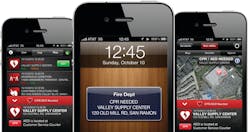EMS: There's an App For That!
When you finish reading this column, go to your computer, pull up YouTube and type in the search words “did you know.” You will find videos that pertain to how technology is changing the world. Among the facts that surprised me: China has more English-speaking people than the entire population of the United States and India has more honor students in its schools than there are children in the United States. Here’s one that really threw me: name this country richest in the world, with the largest military, the center of world business and finance, with the strongest education system, the world center of innovation and invention, its currency the world standard of value and highest standard of living. The answer: England in 1900, not, as I thought, the United States.
The main focus of the “did you know” videos is to show how the world changes and how technology is leading that change. For example, the first text message was sent in 1992. Today, the number of text messages sent and received each day exceeds the population of the world, which as I write this is just under 7 billion.
Fire and EMS has not been immune to this change. As the owner of an iPhone 4S smartphone and an iPad 2 tablet, I use a large amount of apps to make my work easier and that rapidly provide me with information I am looking for. For example, I can listen to the radio channels of my fire department in Memphis, TN, in the event I am notified that something is happening and my radio is not readily available to me. Another app lets me look at the Memphis Fire Department computer-aided dispatching (CAD) system to see real-time events or see computer-generated electronic patient care reports (PCRs) generated by Memphis firefighter/paramedics.
Besides fire and EMS applications, I get “push” notifications to me from the local news media when something is happening in town, and notifications from the national news outlets like CNN and Fox when something newsworthy is happening nationally. Another great app deals with the weather and for one who lives in a tornado-prone area like Memphis, it is great to get “pushed” notifications when severe weather is expected in the area.
Bottom line – there is tons of information that is at the tip of our fingers these days and it can make our jobs much easier. But if you were to search the app or the iTunes store, you would find large amounts of information available related to EMS and fire. Search through the iTunes Store and you will find regular podcasts dealing with EMS and fire that are free. For example, iTunes U has a free video series from Miami-Dade College that deals with a large variety of topics from medication administration to helmet removal to EpiPen use.
One of the most profound uses of an app I have seen comes from the San Ramon Valley Fire Protection District in San Ramon, CA. In January 2011, the district released an app for the iPhone and other phones that lets any citizen provide life-saving assistance to victims of sudden cardiac arrest. A citizen who is trained in CPR and who has downloaded the app is sent a notification that is a cardiac arrest is occurring in the community so that citizen can provide CPR until the fire department arrives. If the cardiac arrest is in a public place, a map shows the location of the closest AED and where it can be found in the building, such as “mounted on wall on second floor outside main gym entrance.” A setting on that app lets you choose notifications, including fires, and a map shows you exactly where emergencies are occurring. Through its foundation, the district makes the app free to other fire departments to install in their communities.
Do a search through the App Store using terms such as EMS, firefighter, paramedic and fire and you will find a large quantity of apps. A search of EMS found 75 apps for the iPad and 249 for the iPhone. Some are free and others range in cost from $14.99 for an EMS Pocket Drug Guide to 99 cents for a scanner monitor for the iPad.
Apps can make your job easier or make reference materials more readily available. They include shift generators, flashcards to study for EMT and paramedic exams, drug calculators, access to police, fire, and EMS radio traffic found on websites and a program that lets you to deal with STEMIs by determining the area of the heart affected by an acute myocardial infarction (MI), plus many more.
In just 20 years, I have seen this explosion of technology and the direct impact it has had on EMS and fire. I can’t even imagine what technology will look like 20 years from now.
For more news and training on EMS, visit http://EMSWorld.com/.
